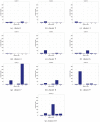A healthcare utilization analysis framework for hot spotting and contextual anomaly detection
- PMID: 23304306
- PMCID: PMC3540544
A healthcare utilization analysis framework for hot spotting and contextual anomaly detection
Abstract
Patient medical records today contain vast amount of information regarding patient conditions along with treatment and procedure records. Systematic healthcare resource utilization analysis leveraging such observational data can provide critical insights to guide resource planning and improve the quality of care delivery while reducing cost. Of particular interest to providers are hot spotting: the ability to identify in a timely manner heavy users of the systems and their patterns of utilization so that targeted intervention programs can be instituted, and anomaly detection: the ability to identify anomalous utilization cases where the patients incurred levels of utilization that are unexpected given their clinical characteristics which may require corrective actions. Past work on medical utilization pattern analysis has focused on disease specific studies. We present a framework for utilization analysis that can be easily applied to any patient population. The framework includes two main components: utilization profiling and hot spotting, where we use a vector space model to represent patient utilization profiles, and apply clustering techniques to identify utilization groups within a given population and isolate high utilizers of different types; and contextual anomaly detection for utilization, where models that map patient's clinical characteristics to the utilization level are built in order to quantify the deviation between the expected and actual utilization levels and identify anomalies. We demonstrate the effectiveness of the framework using claims data collected from a population of 7667 diabetes patients. Our analysis demonstrates the usefulness of the proposed approaches in identifying clinically meaningful instances for both hot spotting and anomaly detection. In future work we plan to incorporate additional sources of observational data including EMRs and disease registries, and develop analytics models to leverage temporal relationships among medical encounters to provide more in-depth insights.
Figures



Similar articles
-
Examining Healthcare Utilization Patterns of Elderly Middle-Aged Adults in the United States.Proc Int Fla AI Res Soc Conf. 2016 May;2016:361-366. Proc Int Fla AI Res Soc Conf. 2016. PMID: 27430035 Free PMC article.
-
The Effectiveness of Integrated Care Pathways for Adults and Children in Health Care Settings: A Systematic Review.JBI Libr Syst Rev. 2009;7(3):80-129. doi: 10.11124/01938924-200907030-00001. JBI Libr Syst Rev. 2009. PMID: 27820426
-
The future of Cochrane Neonatal.Early Hum Dev. 2020 Nov;150:105191. doi: 10.1016/j.earlhumdev.2020.105191. Epub 2020 Sep 12. Early Hum Dev. 2020. PMID: 33036834
-
Evaluation of prenatally diagnosed structural congenital anomalies.J Obstet Gynaecol Can. 2009 Sep;31(9):875-881. doi: 10.1016/S1701-2163(16)34307-9. J Obstet Gynaecol Can. 2009. PMID: 19941713 Review. English, French.
-
Data Processing and Text Mining Technologies on Electronic Medical Records: A Review.J Healthc Eng. 2018 Apr 8;2018:4302425. doi: 10.1155/2018/4302425. eCollection 2018. J Healthc Eng. 2018. PMID: 29849998 Free PMC article. Review.
Cited by
-
Big data analytics for preventive medicine.Neural Comput Appl. 2020;32(9):4417-4451. doi: 10.1007/s00521-019-04095-y. Epub 2019 Mar 16. Neural Comput Appl. 2020. PMID: 32205918 Free PMC article.
-
A system for identifying and investigating unexpected response to treatment.AMIA Jt Summits Transl Sci Proc. 2015 Mar 25;2015:137-41. eCollection 2015. AMIA Jt Summits Transl Sci Proc. 2015. PMID: 26306256 Free PMC article.
-
Unsupervised Anomaly Detection to Characterize Heterogeneity in Type 2 Diabetes.AMIA Jt Summits Transl Sci Proc. 2023 Jun 16;2023:32-41. eCollection 2023. AMIA Jt Summits Transl Sci Proc. 2023. PMID: 37350904 Free PMC article.
-
Predicting High Health Care Resource Utilization in a Single-payer Public Health Care System: Development and Validation of the High Resource User Population Risk Tool.Med Care. 2018 Oct;56(10):e61-e69. doi: 10.1097/MLR.0000000000000837. Med Care. 2018. PMID: 29189576 Free PMC article.
-
Assessing the Value of Unsupervised Clustering in Predicting Persistent High Health Care Utilizers: Retrospective Analysis of Insurance Claims Data.JMIR Med Inform. 2021 Nov 25;9(11):e31442. doi: 10.2196/31442. JMIR Med Inform. 2021. PMID: 34592712 Free PMC article.
References
-
- Barsky AJ, Orav EJ, Bates DW. Distinctive patterns of medical care utilization in patients who somatize. Med Care. 2006;44(9):803–811. - PubMed
-
- Breiman L, Friedman J, Olshen R, Stone C. Classification and Regression Trees. CRC Press; Boca Raton: 1984.
-
- Breiman Leo. Random forests. Machine Learning. 2001;45(1):5–32.
-
- Bussche HVD, Schon G, Kolondo T, Hansen H, Wagscheider K, Glaeske G, Koller D. Patterns of ambolatory medical care utilization in elderly patients with special reference to chronic diseases and multimorbidity - results from a clams data based observational study in germanuy. BMC Geriatrics. 2011;11(1) - PMC - PubMed
MeSH terms
LinkOut - more resources
Full Text Sources
Other Literature Sources
Miscellaneous
